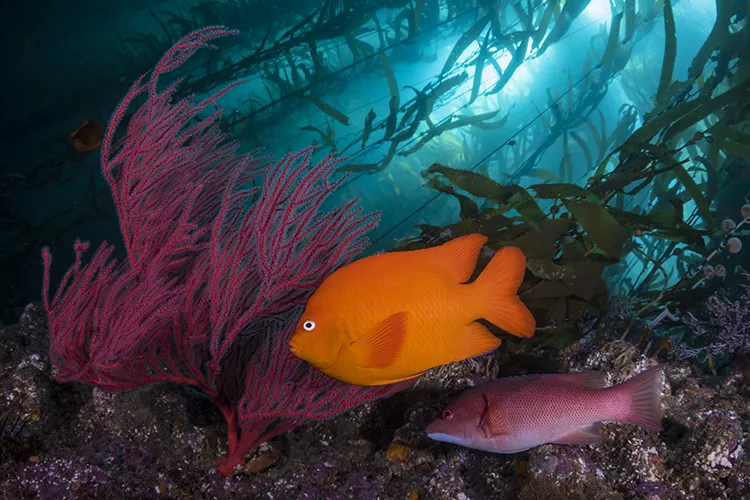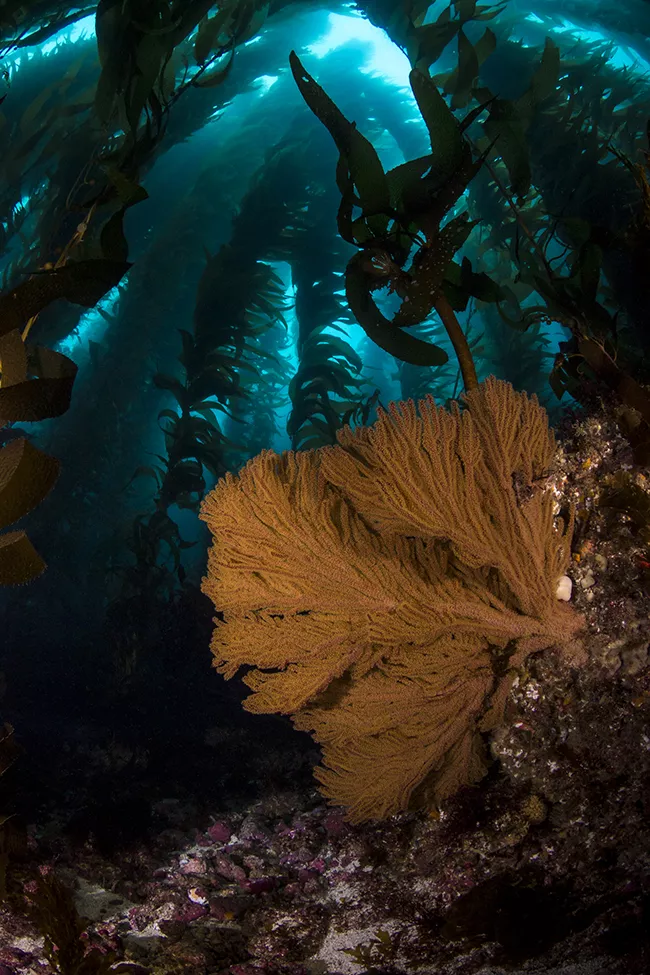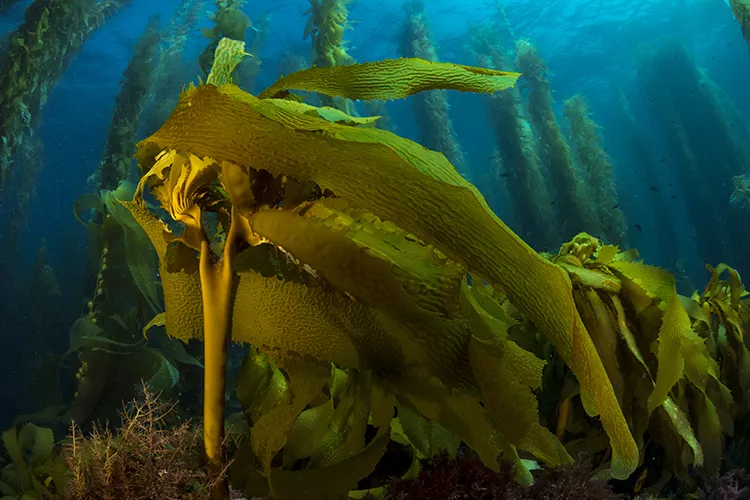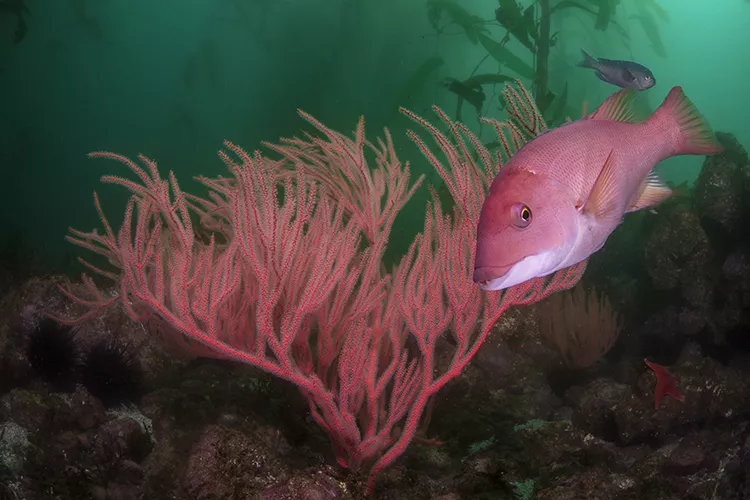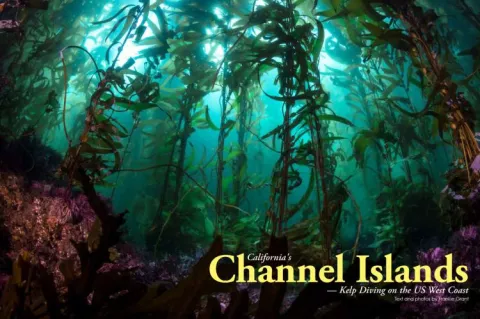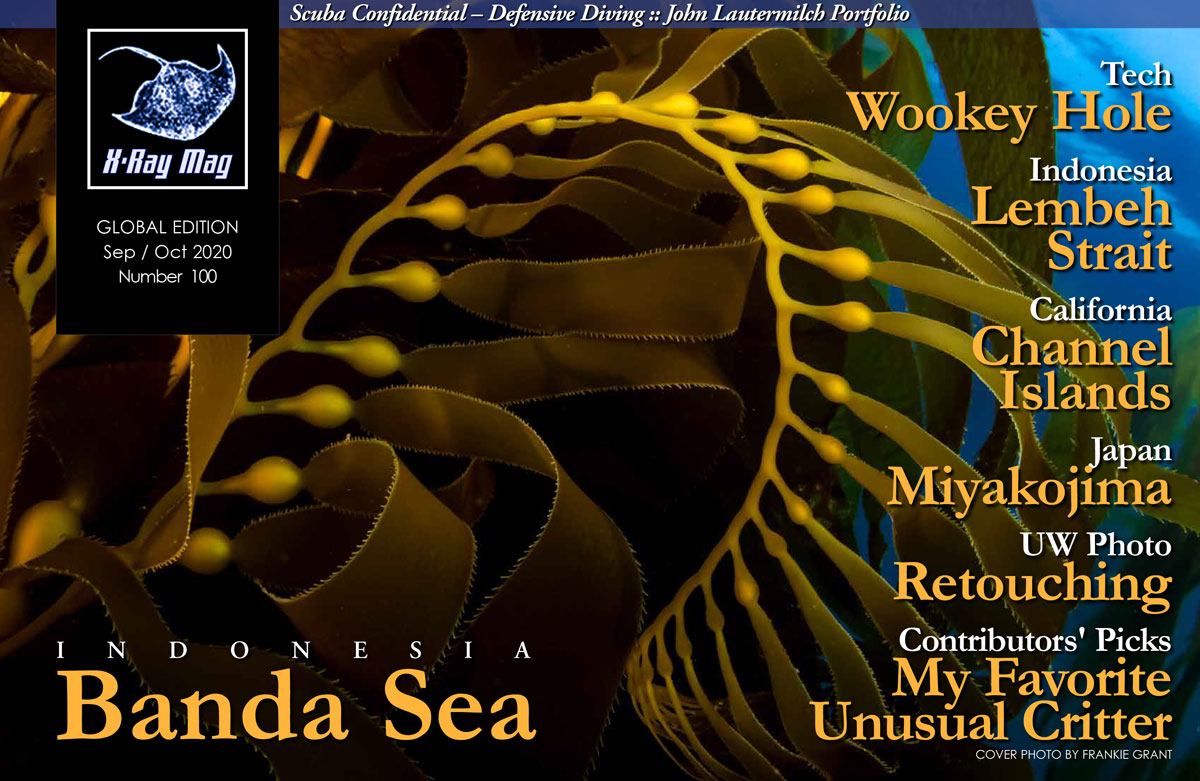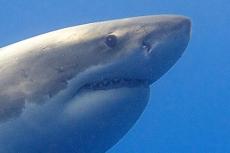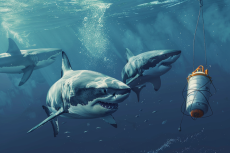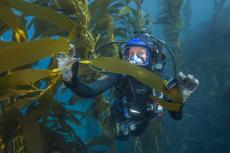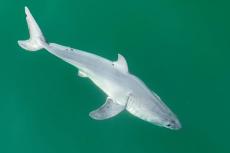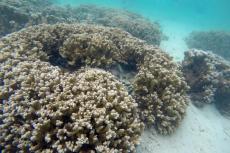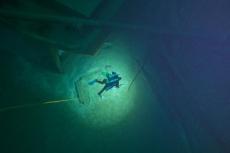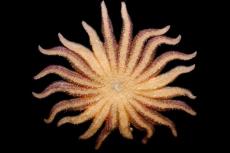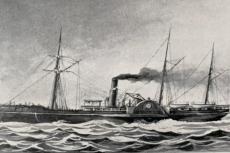Due to their unique position relative to the eastern Pacific current, or the California Current, the Channel Islands off California’s coast receive an ideal amount of nutrients and water circulation for optimum growth of California giant kelp. This colonial algae forms forests over the rocky reefs and walls surrounding the islands, and act as one of the world’s most productive marine ecosystems. Eight islands and numerous offshore seamounts comprise this island chain, which is for the most part uninhabited and full of unique anchorages and protected coves for divers to explore.
Contributed by
Factfile
Frankie Grant is an award-winning American marine photojournalist and PADI scuba instructor who enjoys nothing more that sharing his passion and knowledge of the ocean with his students and peers. Based in San Diego, California, Grant conducts dive expeditions and imaging workshops both locally and abroad. You can see more of his work on his website at: frankiegrant.com, or on Instagram @ oceans.wild.
REFERENCES:
en.wikipedia.org/wiki/Channel_Islands_(California)
en.wikipedia.org/wiki/Macrocystis_pyrifera
en.wikipedia.org/wiki/Scripps’s_murrelet
nps.gov/chis/index.htm
After a smooth night crossing from San Diego, I awoke to the sound of a freed anchor and the gentle tug as it sat firm in the sand. I rose to the deck, eyes wide once the morning’s coffee was prepared, to an almost glass-like sea near the southern tip of San Clemente Island. Cloudy skies presented a grayness over the ocean, but it was no indication of the vibrance and solitude I would soon find beneath the waves.
I sometimes say in jest, SoCal shore divers spend most of the year testing, breaking or losing their new gear with the goal of joining at least one five-day trip out to the Channel Islands. And with good reason; enthusiastic divers can find whatever experiences they are looking for in this area. From beginner up through the ranks, the possibilities are quite endless. Walls lined with kelp, seagrass beds, rocky reefs, canyons, pinnacles, caves, rookeries, wrecks, sandy flats—the list continues with all the possible locations one can explore underwater.
During late summer, visibility can even reach 100ft (30m) at some dive sites, as blue water flowing unobstructed across the Pacific finally meets land. The kelp forest can be viewed as being similar to a rainforest, as distinct zones emerge while moving up or down through the water column. The canopy, understory and floor of the kelp forest all come with their own cast of creatures and characteristics.
Established in 1980, the Channel Islands National Park is comprised of 390 sq mi of protected marine and terrestrial habitat, and are made up of two unique island groups. The Santa Catalina group to the south includes Santa Barbara, San Nicolas, Santa Catalina and San Clemente islands. The Northern Islands are composed of Santa Cruz, Anacapa, San Miguel and Santa Rosa islands.
Archaeologists have traced the history of this archipelago as far back as 7500 BP when the Northern Islands were settled by maritime Paleo-Indian peoples. Today, these islands stretch 150mi (240km) along the southern Pacific coast and are largely pristine.
Getting out there
Located a mere 22mi (35km) from the shore, Santa Catalina, which is the only island with permanent residents, boasts year-round scuba diving, seeing huge spikes during the busy summer season. Apart from Catalina, the Channel Islands are too far a journey for the business-oriented day boat, which puts them comfortably in the range of multiday liveaboard vessels, seeking only the best sites the islands have to offer. Several vessels run multiday trips departing from San Diego, San Pedro, Long Beach, Santa Barbara and Ventura.
For vessels departing from San Diego Harbor, it only takes about six hours to reach San Clemente, although a slower crossing lends itself to a more comfortable sleep schedule and puts divers at the dive site just as the sun rises.
Diving
We are now back to our anchorage at the southern end of San Clemente Island, a little more than 70mi (112.5km) northwest of our departure point at San Diego Harbor. At the southern end of San Clemente, divers will find well-protected walls lined with kelp, hosting a full range of species, ranging from a 7ft (2m) black seabass down to the Porter’s chromodorid, measuring 1.33in (34mm) at most.
Pyramid Cove. I geared up for our morning dive at Pyramid Cove. Glancing over the side of the vessel, I was immediately hypnotized by the view from the top of a kelp stalk down to the rocks maybe 70ft (21m) below. Upon further inspection during my dive, the wall of kelp was constantly buzzing with schools of blacksmiths, señoritas and jack mackerel all looking for their morning meal.
Swiss Cheese. Our next dive was a seldom-visited site known as Swiss Cheese, dubbed so for a large rock outcropping dotted by the many swim-throughs crossing its interior and exiting every rock face except the bottom. I spent half of the dive waiting in the adjacent kelp patch until most of the divers had lost interest in the uninviting tunnels. It was then I could fully examine how intricate the tunnels were; I found myself in awe of the countless crevices filled with more lobsters than one could count.
Santa Catalina Island. North of San Clemente and 30mi (48km) to the south of Long Beach sits Santa Catalina Island. Located in the middle of the Channel Island chain and the closest island to land, Catalina boasts some of the richest kelp forest and largest populations of the endangered black seabass. Although Avalon dive sites are easily accessible to the local shore diver, many exciting dive sites can be explored by boat, such as the famed Farnsworth Banks. The island is surrounded by plunging walls and deep drop-offs, most of which are lined with California giant kelp. At the southern end of the island, in Avalon, shore divers consistently flock to Casino Point, known for its easy logistics and entry. This is one of the most commonly dived shore sites in the entire Channel Islands National Park.
St Nicolas Island. St Nicolas Island’s remoteness and weather-dependency make it a rare treat for divers, but lucky guests will enjoy some of the most pristine kelp forests in all the Channel Islands, including schooling fishes, torpedo rays, oversized lobsters, and occasionally, even tope sharks and harbor seals.
Santa Barbara Island. Popular in both diving and birding circles, Santa Barbara Island is also home to the largest breeding colony for Scripps’s murrelet, a threatened seabird species. Since this habitat has been designated of critical importance, the establishment of a state marine reserve has boosted local populations to incredible levels. The southern side of the island, including Sutil Rock, is composed of rocky reef kelp forests filled with seabass, kelp bass, harbor seals, sea lions, Garibaldi fish and the usual suspects—all going about their day within the protective strands of California giant kelp. The best kept dive secret on this small island is definitely Sutil Rock, where divers will find a dense, shallow kelp forest abutted by a large rock exiting the water on one side and a channel on the other. Keep your eyes open as literally any creature documented in the kelp forest could potentially make an appearance.
Marine life
The migratory nature of many marine mammals off the coast of California lends to the abundance and sightings of cetaceans and pinnipeds throughout the Channel Islands, as the numerous protected bays act as safe harbors for humpbacks making their annual migration as well as hunting grounds for California sea lions living on the coast and venturing far from home to supply vital nourishment to their young.
Throughout the islands, the uneven rocky structure creates plenty of attachment sites not accessible to giant kelp. These areas are normally filled in by red and golden gorgonian colonies filtering the water for nutrients. California sheephead (Semicossyphus pulcher) act as a regulator of the kelp forest, by destroying the very thing which destroys the kelp: purple sea urchins. Their unique mouths allow them to crush prey, such as urchins and bivalves, effortlessly.
In recent years, the islands have come under attack from the purple sea urchins, crippling entire areas of once-productive reefs, turning them into urchin barrens, devoid of life or kelp. Marine protected areas such as the Channel Islands National Park serve to restore balance to this fragile ecosystem through many different projects, including urchin removal and no-take zones.
One creature seldom overlooked is the Garibaldi damselfish (Hypsypops rubicundus). With its orange skin and bold nature, this territorial fish makes its presence known and seemingly spends its entire day arguing with its neighbors. Nonetheless, it is great to see them in such numbers.
Ecology and topography
Kelp fronds move with the surge as sunbeams slowly shine through the empty spaces in the canopy, creating something of a swaying underwater cathedral, complete with patrons going about their day. These are the sights that await a diver on an average day in a Channel Island’s kelp forest, and their memory is not soon forgotten.
While eastern Pacific kelp forests range from Alaska south to Baja, those hidden among the Channel Islands are a benchmark for this diverse, yet threatened, ecosystem. California giant kelp will range from the water’s surface all the way down to depths of over 100ft on the rocky ocean floor. These thick communities of kelp strands act to insulate interior island reefs from the heavier storm surge, creating “mangrove-like” marine zones ideal for juvenile fish and invertebrates. These islands receive cold water currents from the north as well as warm water currents from the south, thus creating a proverbial mixing bowl of ideal conditions for high abundance and species diversity.
In years when the tides are right, giant kelp (Macrocystis pyrifera) can grow at a rate of two feet (70cm) per day, breaking the surface at high tide. Although this may look like a plant in the photos, giant kelp is not a plant at all. It is actually a type of algae belonging to the kingdom Chromista. Most Chromists are single-celled and too small to see with the naked eye, but giant kelp grows to become the largest algae on the planet, reaching over 150ft (45m) long in one growing season.
Afterthoughts
Although conditions here may be challenging, every adventure to the Channel Islands leaves one wanting more and/or revisiting the novel encounters from the last trip. One must go into each dive being flexible in mind, as conditions may change, the wildlife may not be cooperative or there may be a combination of factors which work against us at times, thus increasing one’s stress levels. I believe kelp forests are a place to find serenity and truly observe the ocean realm around us. All that is left for you to do is to find a suitable vessel and climb aboard. Kelp forests of every type and character await you on a trip to California’s Channel Islands. ■
Special thanks go to Truth Aquatics, Horizon Charters and California State Parks.

